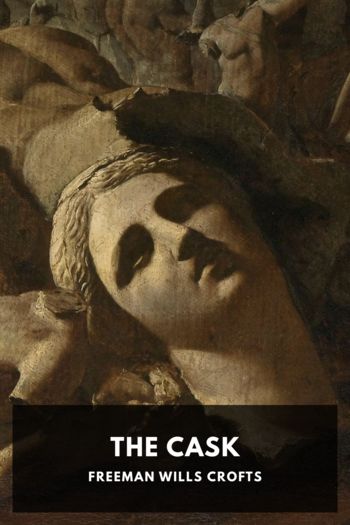The Pit-Prop Syndicate - Freeman Wills Crofts (red queen ebook .TXT) 📗

- Author: Freeman Wills Crofts
Book online «The Pit-Prop Syndicate - Freeman Wills Crofts (red queen ebook .TXT) 📗». Author Freeman Wills Crofts
A little bit higher upstream the clearing of the trees had allowed some stunted shrubs to cluster on the river bank. These appearing to offer good cover, the two men crawled forward and took up a position in their shelter.
The bank they were on was at that point slightly higher than on the opposite side, giving them an excellent view of the wharf and mill as well as of the clearing generally. The ground, as has already been stated, was in the shape of a D, the river bounding the straight side. About halfway up this straight side was the mill, and about halfway between it and the top were the shrubs behind which the watchers were seated. At the opposite side of the mill from the shrubs, at the bottom of the D pillar, the Coburns’ house stood on a little knoll.
“Jolly good observation post, this,” Hilliard remarked as he stretched himself at ease and laid his glass on the ground beside him. “They’ll not do much that we shall miss from here.”
“There doesn’t seem to be much to miss at present,” Merriman answered, looking idly over the deserted space.
About a quarter to eight a man appeared where the lane from the road debouched into the clearing. He walked towards the shed, to disappear presently behind it. Almost immediately blue smoke began issuing from the metal chimney in the shed roof. It was evident he had come before the others to get up steam.
In about half an hour those others arrived, about fifteen men in all, a rough-looking lot in labourers’ kit. They also vanished behind the shed, but most of them reappeared almost immediately, laden with tools, and, separating into groups, moved off to the edge of the clearing. Soon work was in full swing. Trees were being cut down by one gang, the branches lopped off fallen trunks by another, while a third was loading up and running the stripped stems along a Decauville railway to the shed. Almost incessantly the thin screech of the saws rose penetratingly above the sounds of hacking and chopping and the calls of men.
“There doesn’t seem to be much wrong here,” Merriman said when they had surveyed the scene for nearly an hour.
“No,” Hilliard agreed, “and there didn’t seem to be much wrong when I inspected the place on Sunday. But there can’t be anything obviously wrong. If there is anything, in the nature of things it won’t be easy to find.”
About nine o’clock Mr. Coburn, dressed in grey flannel, emerged from his house and crossed the grass to the mill. He remained there for a few minutes, then they saw him walking to the workers at the forest edge. He spent some moments with each gang, afterwards returning to his house. For nearly an hour things went on as before, and then Mr. Coburn reappeared at his hall door, this time accompanied by his daughter. Both were dressed extraordinarily well for such a backwater of civilisation, he with a grey Homburg hat and gloves, she as before in brown, but in a well-cut coat and skirt and a smart toque and motoring veil. Both were carrying dust coats. Mr. Coburn drew the door to, and they walked towards the mill and were lost to sight behind it. Some minutes passed, and between the screaming of the saws the sound of a motor engine became audible. After a further delay a Ford car came out from behind the shed and moved slowly over the uneven sward towards the lane. In the car were Mr. and Miss Coburn and a chauffeur.
Hilliard had been following every motion through his glass, and he now thrust the instrument into his companion’s hand, crying softly:
“Look, Merriman. Is that the lorry driver you saw?” Merriman focused the glass on the chauffeur and recognised him instantly. It was the same dark, aquiline-featured man who had stared at him so resentfully on the occasion of his first visit to the mill, some two months earlier.
“By Jove, what an extraordinary stroke of luck!” Hilliard went on eagerly. “All three of them that know you out of the way! We can go down to the place now and ask for Mr. Coburn, and maybe we shall have a chance to see inside that shed. Let’s go at once, before they come back.”
They crawled away from their point of vantage into the wood, and retracing their steps to the boat, put it together and carried it to the river. Then rowing upstream, they reached the end of the wharf, where a flight of wooden steps came down into the stream. Here they went ashore, after making the painter fast to the woodwork.
The front of the wharf, they had seen from the boat, was roughly though strongly made. At the actual edge, there was a row of almost vertical piles, pine trees driven unsquared. Behind these was a second row, inclined inwards. The feet of both rows seemed to be pretty much in the same line, but the tops of the raking row were about six feet behind the others, the arrangement, seen from the side, being like a V of which one leg is vertical. These tops were connected by beams, supporting a timber





Comments (0)